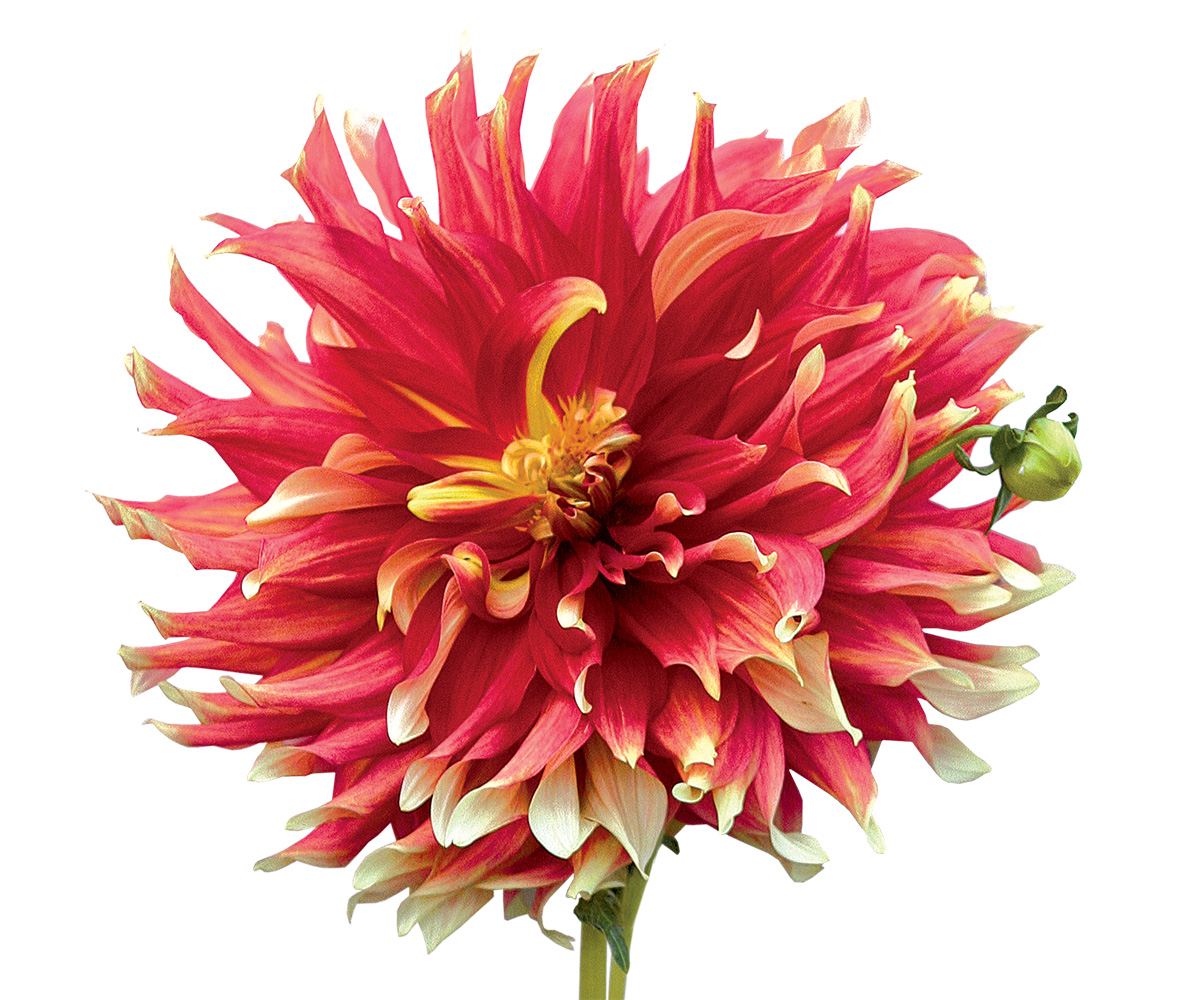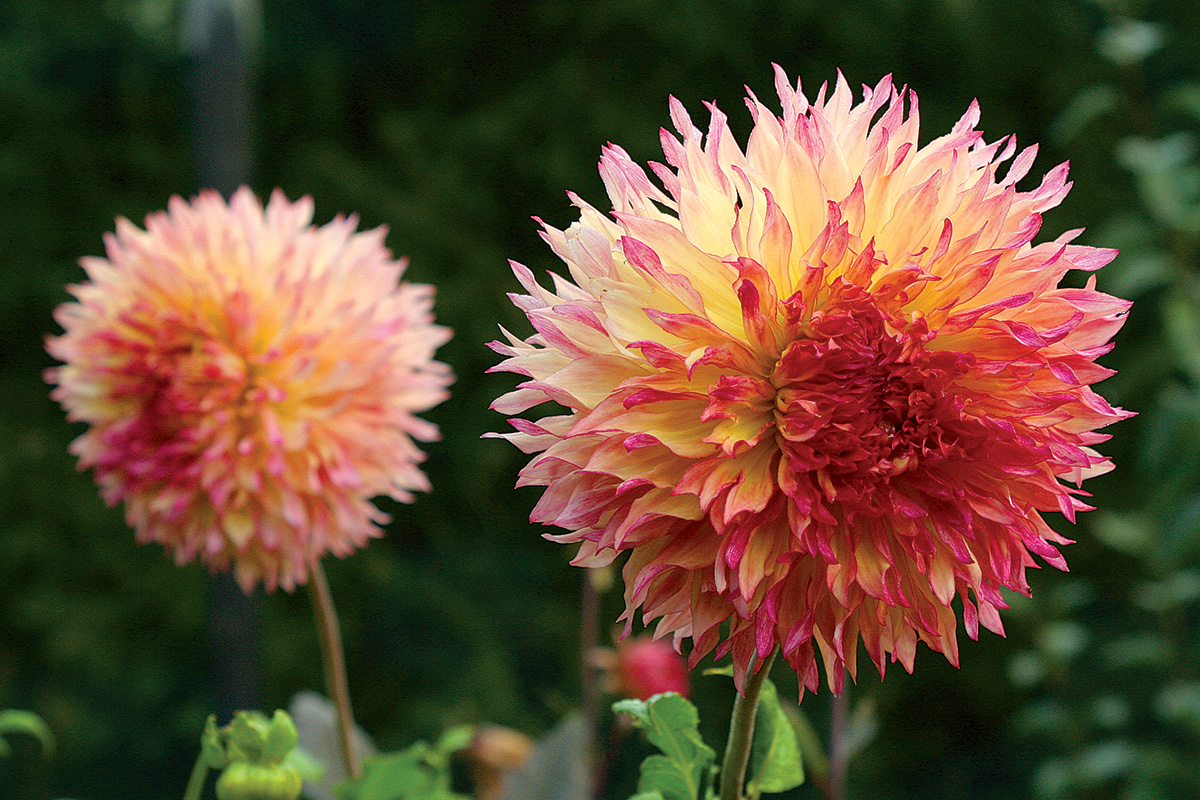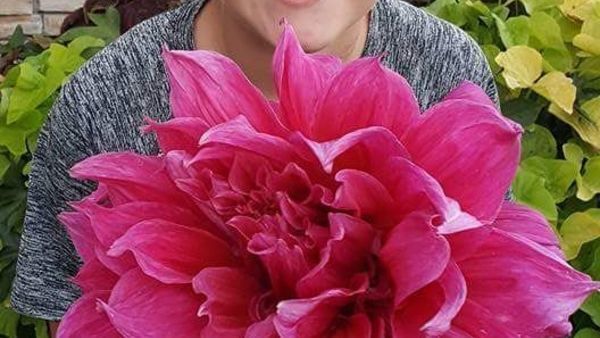
I am not the type of person to say something is great when it’s not, but when it comes to dahlias, I find it easy to rave about their amazing colors and variety of forms. Few plants flower so generously, and dahlia cultivars have been bred into a wide range of growth habits suiting any garden condition—as long as there is plenty of sun. Though most dahlias make superlative border plants—flowering from mid-June until the frosts knock them down—if you have space for only a few pots, you still can enjoy them. If cut flowers are your passion, numerous dahlias have been bred to produce the quintessential cut flower. Dahlias are beautiful, versatile, and able to deliver plentiful flowers to any garden scheme.
The selections that follow represent merely the tip of the iceberg as far as dahlias are concerned. Among the thousands of cultivars available, there is a wealth of variety in form and color. As all gardeners know, nothing worth doing is completely effortless, but with a small amount of well-timed labor, dahlias will always deliver. My favorite varieties are based upon abundance of bloom, quality of color, and reliable performance year after year.
About Growing Dahlias
Dahlia spp. and cvs.
(DAL-ee-ah)
USDA Hardiness Zones: 9–11
Conditions: Full sun, except in the South, where some shade is preferred; well-drained soil
Planting: Tubers may be planted shortly before the last frost date in spring. Dig a hole slightly larger than necessary so that compost can be worked into the backfill. Withhold water until after the first shoots have appeared aboveground, unless the weather is particularly hot and dry. Pinching off the first flower bud will divert the dahlia’s strength into the production of more stems.
Maintenance
Dahlias taller than 3 feet require staking. Insert the first stake into the hole at planting time to avoid skewering the tuber later on. For a swath of dahlias, stretch plastic netting between stout canes for effective support. Remember that larger flowers are heavy, requiring that stems be well supported. Feed with a fertilizer low in nitrogen within a month of planting, then regularly throughout the growing season according to the manufacturer’s instructions. Supplemental watering is only necessary during dry spells. Deadhead spent blooms to keep new flowers coming.
Pests and diseases
Dahlia stems, when they emerge, are attractive to slugs, snails, and rabbits; appropriate measures should be taken to repel them. In a cutting garden, steps should be taken to control any buildup of pests, such as earwigs, that feed on the petals. Aphids can be an issue and should be dealt with immediately to reduce the risk of infection with the debilitating mosaic virus. Good cultivation is the best way to prevent disease and pest problems.
Propagation
Division can be carried out in fall or spring, though the latter is preferred in case of losses over winter. When dividing, use a sharp knife to sever tubers ensuring that each division has at least one eye. Eyes are found on the center stalks and may be hard to see. To avoid mistakes, the whole clump can be cut in half or into smaller sections, but remember to always cut through the center.
Wondering about overwintering?
Photos: How to Store Dahlias for the Winter
Video: How to Dig, Divide, and Store Dahlia Tubers
For larger blooms
If you desire even larger blossoms, you can strategically disbud dahlias by removing most of the buds, leaving just one or two per stalk. This directs the plant’s energy into fewer flowers, resulting in noticeably bigger blooms.
Favorite Types of Dahlias
‘Bodacious’
True to its name, ‘Bodacious’ sports blooms that are a burning combination of colorful, supersize discs on stalks that often grow taller than the advertised 4 feet. The rich color and ruffled effect of the loosely arranged petals make heavy-headed ‘Bodacious’ a choice cut flower requiring stout staking. A true showstopper, it responds well to lifting and storing over winter, enabling dahlia novices in colder climates the chance to possess a star cultivar.
Bloom width: 10 inches or more
Height: 4 feet
‘Bashful’
A reliable and prolific bloomer, ‘Bashful’ sports petals with colors that combine handsomely with their golden stamens. The blooms have a velvety texture and are highly attractive to bees and butterflies, so it’s not always easy to find an unoccupied bloom to cut. That doesn’t matter, however, because ‘Bashful’ looks best in a border, being beautiful and a flower-producing workhorse. Of relatively short stature, it should be planted near the front of a bed, where it will send up an endless succession of richly hued blooms.
Bloom width: 3 inches
Height: 2 to 3 feet
‘Myrtle’s Folly’
‘Myrtle’s Folly’ has one of the more complex blooms you will ever see on a dahlia. The flowers—a dense ball of narrow, irregular, twisted petals of deep pink and light orange—gradually mature to reveal a yellow center. Though slightly ungainly as a border plant, ‘Myrtle’s Folly’ provides a steady supply of wonderful cut flowers that look lovely in a vase, where the frilly, candy-colored concoction of peach and pink can be enjoyed at close quarters.
Bloom width: 6 to 8 inches
Height: 4 feet
‘Honka’
Reminiscent of a kid’s drawing of a star, ‘Honka’ possesses a similarly cheery, simple charm. With a light fragrance, unusual among dahlias, ‘Honka’ brings a subtle show to the late-summer border. Flowers held on sturdy stems hover above the plant and combine well when positioned alongside taller perennials with dark foliage for a backdrop. Its medium height eliminates the need for staking and assigns ‘Honka’ a place right where it looks best—in the front portions of a border.
Bloom width: 3 to 4 inches
Height: 3 feet
‘Pooh’
‘Pooh’ possesses all the naive charm its name suggests. The petals of orange-red, thinly outlined in yellow with an inner ring of gold and lemon-colored petal-like sepals, provide a stunning combination of color and form easy to appreciate from a distance. With numerous small flowers borne on tall plants, this dahlia should be placed farther back in a border, where it is sure to stand out.
Bloom width: 3½ inches
Height: 4½ feet
‘Hissy Fitz’
Despite its humorous moniker, ‘Hissy Fitz’ isn’t as irritable as its name suggests. Quite the reverse: It produces many strong, clear yellow blooms. Due to small incisions at the tip of each petal, the overall effect is of a sunny, softly fringed pom-pom. Not a particularly tall grower, ‘Hissy Fitz’ grows sturdily, with stems that are simple to stake. All these qualities make it an easygoing addition to any sunny border.
Bloom width: 4 to 6 inches
Height: 3½ feet
‘David Howard’
Fine color, substantial size, and vigorous growth make ‘David Howard’ stand out from the crowd. Its blooms are a shade of apricot that contrasts pleasantly with its dark foliage and dark-hued companion plants. ‘David Howard’ is also agreeable both in the company of hot colors, like red and orange, or the cooler shades of blue and purple. It’s a tall grower, which means it requires some staking and looks best in the middle or back of a border, where it will send up an endless succession of blooms that require no deadheading.
Bloom Width: 4 to 6 inches
Height: 4 feet
‘Gallery Art Deco’
This shorter dahlia provides a lot of large flowers for months. ‘Gallery Art Deco’, of the Gallery series, achieves a height of 2 feet, while others of the series reach only 18 inches. ‘Art Deco’, like most of the Gallery series cultivars, bears decorative blooms in a blend of peach and apricot, with a fine outline of burgundy around each petal. Its short stature and abundant blooms make it a fine choice for containers.
Bloom width: 4 to 5 inches
Height: 1 to 2 feet
‘Zorro’
Heavy-headed ‘Zorro’ is breathtaking, particularly as a stemless bloom floating in a bowl of water. Its ruffled-looking form makes its dark red hue look deeper and darker than the deepest, darkest red rose. Staking is absolutely required to prevent the stems from flopping beneath the weight of its huge blooms. Get sturdier stalks by pinching back the young shoots; this will promote increased branching. A confident grower, ‘Zorro’ consistently produces quality tubers for division and, as such, is the perfect cultivar to start or sustain a collection.
Bloom width: 8 to 10 inches
Height: 4 feet
‘Bishop of Llandaff’

One of the most familiar of garden dahlias, ‘Bishop of Llandaff’ is an attention grabber. Its golden-eyed, bright red blooms are all the more vivid set against their sultry foliage—as near black as can be found and more finely dissected than other dahlia cultivars. Though ‘Bishop of Llandaff’ often flops, I rarely stake it. This causes a slightly untidy phase, which is quickly rectified by masses of flowering side shoots. “The Bishop” has recently been superseded in many catalogs by its descendents, including the “Bishop’s Children,” which are sometimes appointed a bishopric of their own (for example, ‘Bishop of York’ or ‘Bishop of Canterbury’). The children bloom in a range of colors softer than the bright red of “The Bishop.”
Bloom width: 4 inches
Height: 3 to 4 feet
‘Bed Head’
A tall plant with striking but relatively small blooms, ‘Bed Head’ works well in the back of a border. Though not as floriferous as other selections, it is special due to its striking, unusually tangled appearance. ‘Bed Head’ is a lush grower and requires strong staking, but as a cut flower in a vase, it is a true work of art.
Bloom width: 4 inches
Height: 5 feet
Alastair Gunn is head gardener at Gitanjali, a private garden in New Canaan, Connecticut.
Photos, except where noted: Daryl Beyers



























Comments
Log in or create an account to post a comment.
Sign up Log in